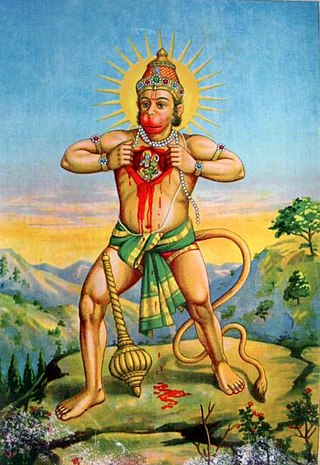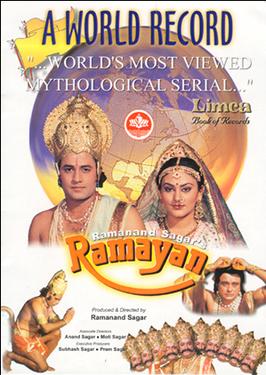
Hanuman, also known as Maruti, Bajrangabali, and Anjaneya, is a deity in Hinduism, revered as an avatar of Shiva, divine vanara, and a devoted companion of the deity Rama. Central to the Ramayana, Hanuman is celebrated for his unwavering devotion to Rama and is considered a chiranjivi. He is traditionally believed to be the spiritual offspring of the wind deity Vayu, who is said to have played a significant role in his birth. His tales are recounted not only in the Ramayana but also in the Mahabharata and various Puranas.

Sugriva is a character In the ancient Indian epic Ramayana. He is the younger brother of Vali, whom he succeeded as ruler of the vanara kingdom of Kishkindha. Rumā is his wife. He is a son of Surya, the Hindu deity of the sun. As the king of the vanaras, Sugriva aided Rama in his quest to liberate his wife Sita from captivity at the hands of the rakshasa king Ravana.

Rambola Dubey, known as Tulsidas, was a Vaishnava (Ramanandi) Hindu saint and poet, renowned for his devotion to the deity Rama. He wrote several popular works in Sanskrit, Awadhi, and Braj Bhasha, but is best known as the author of the Hanuman Chalisa and of the epic Ramcharitmanas, a retelling of the Sanskrit Ramayana, based on Rama's life, in the vernacular Awadhi language. Tulsidas mentioned about destruction of Ram Janmabhumi temple by Mir Baqi in his work Tulsi Doha Shatak and the same was quoted by Rambhadracharya during the proceedings of the Ayodhya dispute in the Allahabad High court that influenced its judgment in 2010.

Anjana, also known as Anjani and Anjali, is the mother of Hanuman, one of the protagonists of the Hindu epic, the Ramayana. She is said to have been a resident of Kishkindha in the text.

Vali also known as Bali, was a vanara and the king of Kishkindha in the Hindu epic Ramayana. He was the husband of Tara, the son of Indra, the elder brother of Sugriva, and the father of Angada.

Ramcharitmanas, is an epic poem in the Awadhi language, based on the Ramayana, and composed by the 16th-century Indian bhakti poet Tulsidas. This work is also called, in popular parlance, Tulsi Ramayana, Tulsikrit Ramayana, Tulsidas Ramayana or simply Manas. The word Ramcharitmanas literally means "Lake of the deeds of Rama". It is considered one of the greatest works of Hindu literature. The work has variously been acclaimed as "the living sum of Indian culture", "the tallest tree in the magic garden of medieval Indian poetry", "the greatest book of all devotional literature" and "the best and most trustworthy guide to the popular living faith of the Indian people".

Sundara Kanda is the fifth book in the Hindu epic Ramayana. The original Sundara Kanda is in Sanskrit, and was composed in popular tradition by Valmiki, who was the first to scripturally record the Ramayana. Sundara Kanda is the only chapter of the Ramayana in which the principal protagonist is not Rama, but Hanuman. The work depicts the adventures of Hanuman and his selflessness, strength, and devotion to Rama are emphasised in the text. Hanuman is believed to have been fondly called “Sundara” by his mother Anjana, and Sage Valmiki is stated to have chosen this name over others as the Sundara Kanda is about Hanuman's journey to Lanka.

Hanuman Temple in Connaught Place, New Delhi, India, is an ancient Hindu temple and is claimed to be one of the five temples of Mahabharata days in Delhi. The other four temples are the Kalkaji, a Kali temple in South Delhi containing Swayambu rock Idol, the Yogmaya Temple near Qutub Minar, the Bhairav temple near the Purana Qila and the Nili Chatri Mahadev at Nigambodh Ghat outside the walls of Old Delhi.

Ramayan is an Indian Hindi-language epic television series based on ancient Indian Sanskrit Epic Ramayana. The show was created, written, and directed by Ramanand Sagar. It originally aired between 1987 and 1988 on DD National and it was narrated by Ashok Kumar and the director Ramanand Sagar. The music was composed by Ravindra Jain. During its run, the show became most watched television series in the world, and it is the most watched mythological serial in the world, it had a viewership of 82 percent. The repeat telecast was aired on 20 different channels in 17 countries on all the five continents at different times. The success of the series was documented well by the media. According to BBC, the serial has been viewed by over 650 million viewers. Each episode of the series reportedly earned DD National ₹40 lakh.

Arun Govil is an Indian actor. He is best known for portraying Lord Rama in Ramayan TV series (1987-1988). He also appeared in films like Paheli (1977), Sawan Ko Aane Do (1979), Saanch Ko Aanch Nahin (1979), Jiyo To Aise Jiyo (1981), Himmatwala (1983), Dilwaala (1986), and Govinda Govinda (1994).

Kishkindha is a kingdom of the vanaras in Hinduism. It is ruled by King Sugriva, the younger brother of Vali, in the Sanskrit epic Ramayana. According to the Hindu epic, this was the kingdom that Sugriva ruled with the assistance of his counsellor, Hanuman.

Kasamh Se is an Indian soap opera produced by Ekta Kapoor of Balaji Telefilms. The show aired on Zee TV from 16 January 2006 to 12 March 2009. The story is about three sisters: Bani, Piya and Rano.

Ramayana: The Epic is a 2010 Indian Hindi-language computer-animated mythological action film from Maya Digital Media. Directed by Chetan Desai and produced by Ketan Mehta, it was released by Warner Bros. India on 15 October 2010.
Jai Hanuman is a 1997 Indian television series based on the life of the Hindu deity Hanuman, an avatar of Shiva, in Hindi. It was directed by Sanjay Khan. The series was initially shown on the state-run DD National, and was later shown on Sony Entertainment Television in 2008.
Ramleela – Ajay Devgn Ke Saath, commonly known as Ramleela is a mythological on-stage musical drama, based on the famous Indian epic poem Ramayan. The show premiered on 21 October 2012 on Life OK and completed the story in five episodes on 18 November 2012. The show was narrated by Bollywood actor Ajay Devgn, who provided a prologue at the beginning of each episode or act. The show aired during the period from Dussehra in October till Diwali in November.

Manoj Shukla, better known by his stage name Manoj Muntashir Shukla, is an Indian lyricist, poet, dialogue writer and screenwriter. He wrote several Hindi songs for films, including "Teri Mitti", "Galliyan", "Tere Sang Yaara", "Kaun Tujhe", "Dil Meri Na Sune", "Kaise Hua" and "Phir Bhi Tumko Chaahunga".

Sankat Mochan Mahabali Hanumaan is an Indian-Television drama series that aired on Sony Entertainment Television (India) weekly. It depicts the story of Lord Hanuman told from the viewpoint of Lord Shri Krishna and Devi Rukmini. The series ran from May 2015 to August 2017.

Siya Ke Ram is an Indian TV series on Star Plus produced by Nikhil Sinha under the banner of Triangle Film Company. This show presents the epic Ramayana, the story of Rama and Devi Sita from Sita's perspective. The show features Madirakshi Mundle and Ashish Sharma playing as Goddess Sita and Lord Rama, respectively, and Karthik Jayaram as Raavan. It premiered on 16 November 2015 and ended on 4 November 2016.

Ramayan is a Hindi TV series that was aired on Zee TV in 2001. It is a television adaptation of the ancient Indian epic of the same name, and is primarily based on Valmiki's Ramayana, Tulsidas Ramcharitramanas, Kalidasa's Raghuvaṃśa and Kambar's Kambh Ramayana. It was produced and directed by Baldev Raj Chopra and Ravi Chopra.

Good Newwz is an Indian 2019 Hindi-language comedy-drama film directed by Raj Mehta and produced by Dharma Productions and Cape of Good Films. It stars Akshay Kumar, Kareena Kapoor Khan, Diljit Dosanjh and Kiara Advani and revolves around two couples' tryst with in vitro fertilization.


















